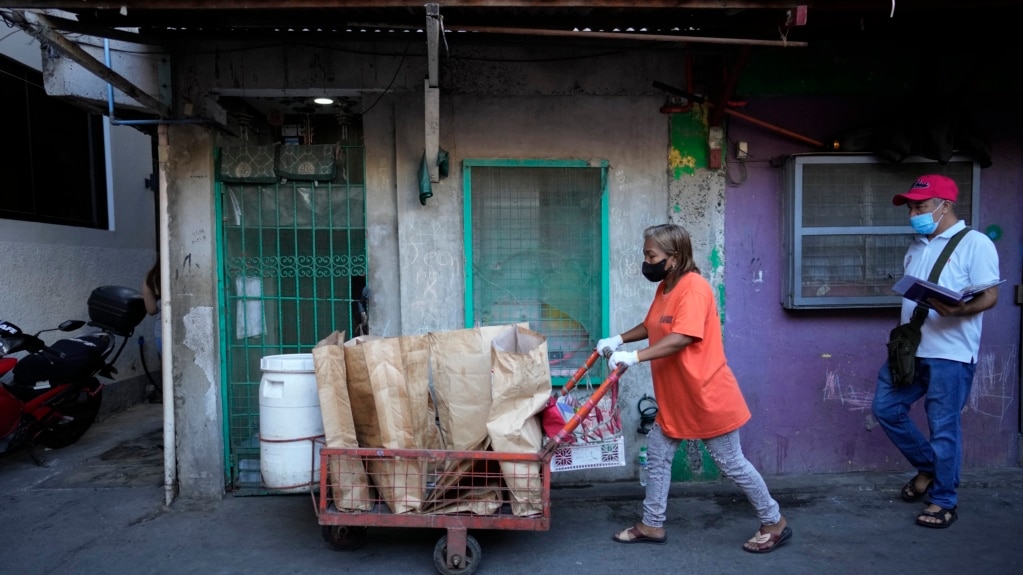Along the streets of Malabon in the Philippines, Marilene Capentes pushes a cart every morning except Sundays. The city of Malabon is just north of the capital, Manila.
Capentes is a waste picker. She collects bags of separated garbage, placing food waste in one container. This material will be turned into compost at the local recycling facility. The rest of the waste goes into separate containers. The recyclable materials are later sold.
Capentes said the heavy garbage used to be all mixed together. Then a few years ago, a local environmental nonprofit started asking people to separate their garbage.
The Mother Earth Foundation in the Philippines is a member of the Global Alliance for Incinerator Alternatives, called GAIA. The organization wants to prevent food waste from going to landfills. Food waste gives off methane gas as it breaks down. Methane is a powerful greenhouse gas.
Methane traps more heat than carbon dioxide. But it does not stay in the atmosphere nearly as long -- around 12 years compared with hundreds of years.
GAIA says preventing organic waste from going to landfills or being burned is a proven and cost-effective climate solution. The environmental organization supports its members, including waste pickers, around the world. GAIA is working with governments to set up systems to separate and collect organic waste and establish facilities to compost it.
At a materials recycling facility in Malabon, organic waste collected from households is turned into compost. This material then goes into a community garden to grow vegetables. Some of the food waste is broken down into biogas. This biogas is then used to cook vegetables for waste workers to eat.
It is a complete cycle, said Froilan Grate, chief of GAIA Asia Pacific, based in Manila.
Grate said there are challenges in establishing these systems in new places. It costs money to set up a facility for composting. People, including local officials, have to be educated on the importance of separating waste. Containers have to be provided to households that cannot buy more than one.
And sometimes separating organic waste is not thought to be important. Also, unlike recyclables and metals, there is not a large market for organic materials. Therefore, waste workers must be paid for the system to work.
But Grate believes these problems can be solved. More people are making the connection between reducing methane and fighting climate change.
The world needs better systems for dealing with waste because the current methods are adding to warming, said Kait Siegel. She leads the methane pollution prevention team at the environmental nonprofit Clean Air Task Force. She said the treatment of organic matter is an important way to reduce methane gas.
“We’ve seen these solutions make a difference in countries around the world,” she said. “We’re all creating organic waste in our day-to-day lives….”
The Global Methane Pledge, launched in November 2021, has pushed countries to examine their sources of methane. More than 100 countries, including the United States, have agreed to reduce methane emissions by 30 percent by 2030. However, other countries that produce large amounts of methane refused.
Brazil is one of the world’s five largest methane creators. Since President Luiz Inácio Lula da Silva took office in January, there has been growing support for waste pickers, waste recycling, and fighting climate change, said Victor Hugo Argentino de Morais Vieira. He is a waste adviser and researcher at Instituto Pólis, a non-governmental, non-profit organization in Brazil.
In Bahia, a popular tourist area, a large composting site has been operating for years. Waste pickers there developed a system for their work collecting organic garbage from hotels and restaurants. But few other waste pickers collect food waste.
In South Africa, it is also not common to separate organic waste. But for the past two years the idea has been tested at a large market in the port city of Durban.
“It can be a game changer for the continent,” said Niven Reddy, the African regional coordinator for GAIA. “It can be tested and tried. If it works in Africa in one place, it’s likely to work someplace else — 400,000 people go through that market a day.”
GAIA leaders like Reddy are looking to the systems established in the Philippines as a model.
I’m Anna Matteo. And I’m Andrew Smith.

